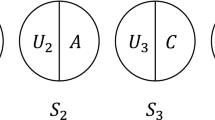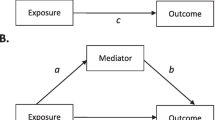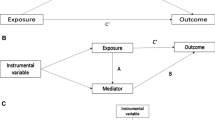Abstract
The minimal sufficient cause (MSC) model, also known as the sufficient component cause model, has been used to facilitate understanding of several key concepts in epidemiology. To improve the understanding of mediation, we introduce a causal model for mediation that is grounded in the MSC approach. First, we describe an unbiased model for mediation, to clarify the causal meaning of previously described indirect effects. Through the use of potential outcomes and response types, we express each indirect (and direct) effect in terms of component causes within the MSC model. Second, we use an MSC-based model to illustrate a common cause of the mediator and outcome, i.e. a confounder of the mediator–outcome relationship. By describing this potential source of bias within the MSC-based model, important complexities are noted that impact the magnitude of plausible confounding. In conclusion, an MSC-based approach leads to several important insights concerning the interpretation of indirect and direct effects, as well as the potential sources of bias in mediation analysis.


Similar content being viewed by others
References
Skrabanek P. The emptiness of the black box. Epidemiology. 1994;5(5):553–5.
Susser M, Susser E. Choosing a future for epidemiology: II. From black box to Chinese boxes and eco-epidemiology. Am J Public Health. 1996;86(5):674–7.
Weed DL. Beyond black box epidemiology. Am J Public Health. 1998;88(1):12–4.
Hafeman D. Opening the black box: a reassessment of mediation from a counterfactual perspective. Dissertation. Columbia University, New York; 2008.
Susser E, et al. Psychiatric epidemiology: searching for causes of mental disorders. London: Oxford University Press; 2006. p. 422–8.
Marmot M, Wilkinson RG. Psychosocial and material pathways in the relation between income and health: a response to Lynch et al. BMJ. 2001;322(7296):1233–6. doi:10.1136/bmj.322.7296.1233.
Marmot MG, et al. Contribution of job control and other risk factors to social variations in coronary heart disease incidence. Lancet. 1997;350(9073):235–9. doi:10.1016/S0140-6736(97)04244-X.
Lynch JW, et al. Income inequality and mortality: importance to health of individual income, psychosocial environment, or material conditions. BMJ. 2000;320:1200–4.
MacKinnon DP. Analysis of mediating variables in prevention and intervention research. NIDA Res Monogr. 1994;139:127–53.
Rothman KJ, Greenland S. Modern epidemiology. 2nd ed. Philadelphia, PA: Lippincott Williams and Wilkins; 1998. 738 pp.
Szklo M, Nieto FJ. Epidemiology: beyond the basics. Gaithersburg, MD: Aspen Publishers; 2000.
Rothman KJ, Greenland S, Lash TL. Modern epidemiology. 3rd ed. Philadelphia, PA: Lippincott Williams and Wilkins; 2008. p. 200–2.
Pearl J. Direct and indirect effects. In: Proceedings of the American Statistical Association Joint Statistical Meetings. Minneapolis, MN: MIRA Digital Publishing; 2001.
Petersen ML, Sinisi SE, van der Laan MJ. Estimation of direct causal effects. Epidemiology. 2006;17(3):276–84. doi:10.1097/01.ede.0000208475.99429.2d.
Robins JM, Greenland S. Identifiability and exchangeability for direct and indirect effects. Epidemiology. 1992;3(2):143–55. doi:10.1097/00001648-199203000-00013.
Darroch J. Biologic synergism and parallelism. Am J Epidemiol. 1997;145(7):661–8.
Greenland S, Robins JM. Identifiability, exchangeability, and epidemiological confounding. Int J Epidemiol. 1986;15(3):413–9. doi:10.1093/ije/15.3.413.
Miettinen OS. Causal and preventive interdependence. Elementary principles. Scand J Work Environ Health. 1982;8(3):159–68.
Rothman KJ. Causes. Am J Epidemiol. 1976;104(6):587–92.
Mackie JL. The cement of the Universe: a study of causation. New York: Oxford University Press; 1974.
VanderWeele TJ, Robins JM. The identification of synergism in the sufficient-component-cause framework. Epidemiology. 2007;18(3):329–39. doi:10.1097/01.ede.0000260218.66432.88.
Ahsan H, et al. Health Effects of Arsenic Longitudinal Study (HEALS): description of a multidisciplinary epidemiologic investigation. J Expo Sci Environ Epidemiol. 2006;16(2):191–205. doi:10.1038/sj.jea.7500449.
Greenland S, Poole C. Invariants and noninvariants in the concept of interdependent effects. Scand J Work Environ Health. 1988;14(2):125–9.
Kaufman JS, Maclehose RF, Kaufman SA. A further critique of the analytic strategy of adjusting for covariates to identify biologic mediation. Epidemiol Perspect Innov. 2004;1(1):4. doi:10.1186/1742-5573-1-4.
Greenland S, Pearl J, Robins JM. Causal diagrams for epidemiologic research. Epidemiology. 1999;10(1):37–48. doi:10.1097/00001648-199901000-00008.
VanderWeele TJ, Robins JM. Directed acyclic graphs, sufficient causes, and the properties of conditioning on a common effect. Am J Epidemiol. 2007;166(9):1096–104. doi:10.1093/aje/kwm179.
Greenland S, Brumback B. An overview of relations among causal modelling methods. Int J Epidemiol. 2002;31(5):1030–7. doi:10.1093/ije/31.5.1030.
Flanders WD. On the relationship of sufficient component cause models with potential outcome (counterfactual) models. Eur J Epidemiol. 2006;21:847–53.
MacKinnon DP, Fairchild AJ, Fritz MS. Mediation analysis. Annu Rev Psychol. 2007;58:593–614. doi:10.1146/annurev.psych.58.110405.085542.
Judd CM, Kenny DA. Process analysis: estimating mediation in treatment evaluations. Eval Rev. 1981;5(5):602–19. doi:10.1177/0193841X8100500502.
Cole SR, Hernan MA. Fallibility in estimating direct effects. Int J Epidemiol. 2002;31(1):163–5. doi:10.1093/ije/31.1.163.
Pearl J. Causality: models, reasoning and inference. Cambridge: Cambridge University Press; 2000. p. 78–85.
Acknowledgements
The author would like to acknowledge Sharon Schwartz for her insightful input, guidance, and mentorship. She would also like to thank Tyler VanderWeele, Maria Glymour, and Ezra Susser for their helpful comments on this manuscript.
Author information
Authors and Affiliations
Corresponding author
Appendix: Direct effects (PDE and TDE) in terms of potential outcomes, response types, and the MSC model for mediation
Appendix: Direct effects (PDE and TDE) in terms of potential outcomes, response types, and the MSC model for mediation
The pure direct effect (PDE) is the effect that the exposure would have if exposure did not cause the mediator. In terms of the current example, the PDE would be the effect of arsenic on death if arsenic did not cause skin lesions. Operationalized in terms of potential outcomes, the PDE is a comparison between (1) the risk of death if everyone were exposed to arsenic, but had the skin lesions they would have had were they unexposed \( \left[ {{\text{P}}\left( {{\text{Y}}_{{1{\text{M}}_{0} }} = 1} \right)} \right] \) and (2) the risk of death if everyone were unexposed to arsenic \( \left[ {{\text{P}}\left( {{\text{Y}}_{{0{\text{M}}_{0} }} = 1} \right)} \right]. \)
The difference between \( {\text{P}}\left( {{\text{Y}}_{{ 1 {\text{M}}_{0} }} = 1} \right) = {\text{P}}\left( {{\text{Y}}^{\text{T}}_{ 1} + {\text{Y}}^{\text{T}}_{ 2} + {\text{Y}}^{\text{T}}_{ 4} + {\text{M}}^{\text{T}}_{ 1} {\text{Y}}^{\text{T}}_{ 6} + {\text{M}}^{\text{T}}_{ 1} {\text{Y}}^{\text{T}}_{ 8} } \right) \) and \( {\text{P}}\left( {{\text{Y}}_{{0{\text{M}}_{0} }} = 1} \right) = {\text{P}}\left( {{\text{Y}}^{\text{T}}_{1} + {\text{M}}^{\text{T}}_{1} {\text{Y}}^{\text{T}}_{6} + {\text{M}}^{\text{T}}_{1} {\text{Y}}^{\text{T}}_{2} } \right) \) is: \( {\text{PDE}} = {\text{P}}\left( {{\text{Y}}^{\text{T}}_{ 4} + {\text{M}}^{\text{T}}_{ 1} {\text{Y}}^{\text{T}}_{ 8} + {\text{M}}^{\text{T}}_{ 2} {\text{Y}}^{\text{T}}_{ 2} + {\text{M}}^{\text{T}}_{ 4} {\text{Y}}^{\text{T}}_{ 2} } \right) \) (Table 5 and Appendix Table 1). Intuitively, the PDE is equal to the proportion of individuals for whom skin lesions directly causes death (Y T4 ); plus those who have skin lesions regardless of arsenic exposure (M T1 ) and for whom skin lesions and arsenic interact to cause death (Y T8 ); plus those who do not have skin lesions in the absence of arsenic exposure (M T2 or M T4 ) and for whom either skin lesions or arsenic cause death (Y T2 ). In terms of component causes within the MSC model, the PDE consists of individuals who (1) do not have L or K, but have C or (2) do not have L or B, but have K and (C or F).
The total direct effect (TDE) is the effect that the exposure would have if lack of exposure did not prevent the mediator. Given the current example, the TDE would be the effect of arsenic on death if lack of arsenic did not prevent skin lesions; that is, if everyone (both the unexposed and the exposed) had the skin lesions they would have had were they exposed. In terms of potential outcomes, the TDE is a comparison between (1) the risk of death if everyone were exposed to arsenic \( \left[ {{\text{P}}\left( {{\text{Y}}_{{1{\text{M}}_{1} }} = 1} \right)} \right]. \) and (2) the risk of death if everyone were unexposed to arsenic, but had the skin lesions they would have were they exposed \( \left[ {{\text{P}}\left( {{\text{Y}}_{{0{\text{M}}_{1} }} = 1} \right)} \right]. \)
Based on Table 5, the TDE is the difference between \( {\text{P}}\left( {{\text{Y}}_{{ 1 {\text{M}}_{1} }} = 1} \right) = {\text{P}}\left( {{\text{Y}}^{\text{T}}_{ 1} + {\text{Y}}^{\text{T}}_{ 2} + {\text{Y}}^{\text{T}}_{ 4} + {\text{M}}^{\text{T}}_{ 1} {\text{Y}}^{\text{T}}_{ 6} + {\text{M}}^{\text{T}}_{ 1} {\text{Y}}^{\text{T}}_{ 8} + {\text{M}}^{\text{T}}_{ 2} {\text{Y}}^{\text{T}}_{ 6} + {\text{M}}^{\text{T}}_{ 2} {\text{Y}}^{\text{T}}_{ 8} } \right) \) and \( {\text{P}}\left( {{\text{Y}}_{{0{\text{M}}_{1} }} = 1} \right) = {\text{P}}\left( {{\text{Y}}^{\text{T}}_{ 1} + {\text{M}}^{\text{T}}_{ 1} {\text{Y}}^{\text{T}}_{ 6} + {\text{M}}^{\text{T}}_{ 1} {\text{Y}}^{\text{T}}_{ 2} + {\text{M}}^{\text{T}}_{ 2} {\text{Y}}^{\text{T}}_{ 6} + {\text{M}}^{\text{T}}_{ 2} {\text{Y}}^{\text{T}}_{ 2} } \right); \) it follows that the \( {\text{TDE}} = {\text{P}}\left( {{\text{Y}}^{\text{T}}_{4} + {\text{M}}^{\text{T}}_{1} {\text{Y}}^{\text{T}}_{8} + {\text{M}}^{\text{T}}_{2} {\text{Y}}^{\text{T}}_{8} + {\text{M}}^{\text{T}}_{4} {\text{Y}}^{\text{T}}_{2} } \right) \) (Table 5 and Appendix Table 1). Intuitively, the TDE is equal to the proportion of individuals for whom skin lesions directly causes death (Y T4 ); plus those who have skin lesions in the presence of arsenic exposure (M T1 or M T2 ) and for whom skin lesions and arsenic interact to cause death (Y T8 ); plus those who do not have skin lesions, even in the presence of arsenic exposure (M T4 ) and for whom either skin lesions or arsenic cause death (Y T2 ). In terms of the MSC model, the TDE consists of individuals who (1) do not have L, K,or A, but have C or (2) do not have L or B, but have (K or A) and (C or F).
Similar to the indirect effects, the difference between the pure and total direct effect is due to the differential placement of parallelism and synergy. While the TDE includes mediated synergistic types (M T2 Y T8 ), it excludes mediated parallel types (M T2 Y T2 ). In contrast, the PDE includes mediated parallel types (M T2 Y T2 ), while excluding mediated synergistic types (M T2 Y T8 ).
Rights and permissions
About this article
Cite this article
Hafeman, D.M. A sufficient cause based approach to the assessment of mediation. Eur J Epidemiol 23, 711–721 (2008). https://doi.org/10.1007/s10654-008-9286-7
Received:
Accepted:
Published:
Issue Date:
DOI: https://doi.org/10.1007/s10654-008-9286-7




